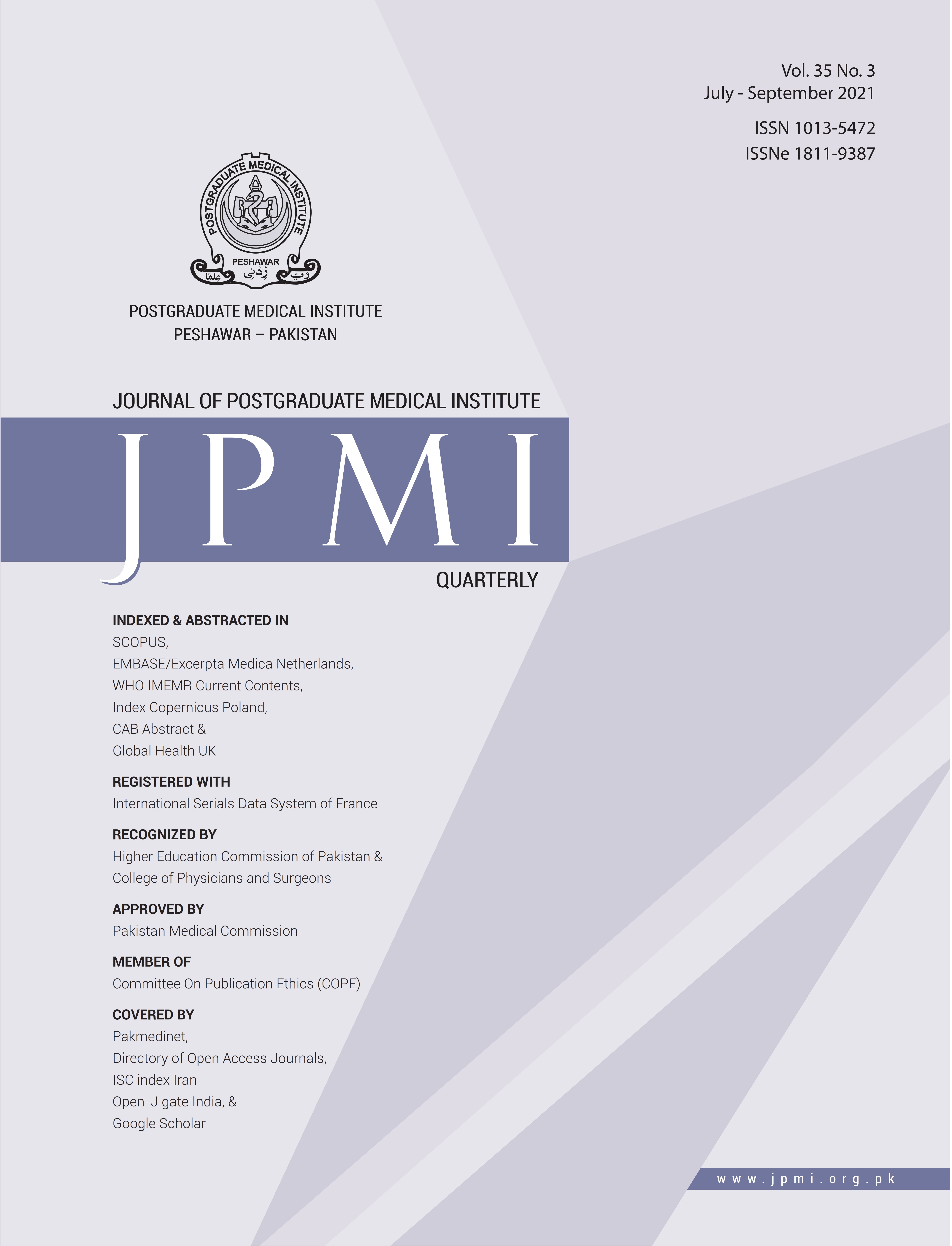EXPLORING CAUSES OF STILLBIRTHS THROUGH RECODE CLASSIFICATION: A 4 YEAR EXPERIENCE IN TERTIARY CARE HOSPITAL
Main Article Content
Abstract
OBJECTIVE: To study the causes of stillbirths through recode classification over 4 years in tertiary care hospital.
METHODOLOGY: This was a descriptive study, with non-probability consecutive sampling, carried out from January 2016 till December 2019 in Lady Reading Hospital, which is a tertiary care hospital. Ethical approval was taken for the study. Relevant condition at death was recorded against the following headings under ReCoDe classification (along with the sub classifications) as a. Fetus b. Umbilical cord c. Placenta d. Amniotic fluid e. Uterus f. Mother g. Intrapartum h. Trauma i. Unclassified. Data was analysed on the Statistical Package for Social Science (SPSS) version 23.
RESULTS: The stillbirth rate recorded over 4 studied years was 7.8%, 6.4%, 5.9%and 4.7% in 2016 ,2017, 2018 and 2019 respectively. It was observed that the most common relevant conditions at birth of stillborn babies were associated with fetal, maternal and placental causes. Fetal causes were, however, mainly contributed by congenital abnormalities (65.63%, 79%, 58.11% and 74% respectively). Among the placental causes, placental abruption remained the main killer (54%, 72%, 78% and 76%). Among the maternal causes, diabetes and hypertension contributed the most. Of other notable causes, ruptured uterus was found to be an important entity taking its toll each year (6%, 4%, 6% and 5.3% respectively).
CONCLUSIONS: ReCoDe classification is effective for use as data recording tool related to stillbirths.
Article Details
Work published in JPMI is licensed under a
Creative Commons Attribution-NonCommercial 2.0 Generic License.
Authors are permitted and encouraged to post their work online (e.g., in institutional repositories or on their website) prior to and during the submission process, as it can lead to productive exchanges, as well as earlier and greater citation of published work.
References
Hug L, You D, Blencowe H, Mishra A, Wang Z, Fix MJ, et al. Global, region¬al, and national estimates and trends in stillbirths from 2000 to 2019: a systematic assessment. Lancet 2021; 398(10302):772-85.
Lawn JE, Blencowe H, Waiswa P, Amou¬zou A, Mathers C, Hogan D, et al. Still¬births: rates, risk factors, and accel¬eration towards 2030. Lancet 2016; 387(10018):587-603.
Stillbirth estimates. 2020. Available from: URL: https://data.unicef.org/top¬ic/child-survival/stillbirths/.
Aziz A, Saleem S, Nolen TL, Pradhan NA, McClure EM, Jessani S, et al. Why are the Pakistani maternal, fetal and newborn outcomes so poor compared to other low and middle-income coun¬tries? Reprod Health. 2020; 17(3):190.
Waqar F. Why have the MDGs failed? The News. [cited 2017 March 9]. Avail¬able from: URL: https://www.thenews. com.pk/print/191044-why-have-the-mdgs-failed.
World Health Organization. Trends in maternal mortality: 1990 to 2013. Es¬timates by WHO, UNICEF, UNFPA, The World Bank and the United Nations Pop¬ulation Division. Geneva: WHO; 2014.
World Health Organization. Every new¬born action plan, country progress tracking report. Geneva: UNICEF; 2015.
Shiffman J, Smith S. Generation of political priority for global health ini¬tiatives: a framework and case study of maternal mortality. Lancet. 2007; 370(9595):1370-9.
Smith SL, Shiffman J, Kazembe A. Gen¬erating political priority for newborn survival in three low-income countries. Glob Pub health. 2014; 9(5):538-54.
World Health Organization. International statistical classification of diseases and related health problems. Geneva: WHO; 2004.
Hug L, Mishra A, Lee S, You D, Moran A, Strong KL, et al. A neglected tragedy The global burden of stillbirths: report of the UN inter-agency group for child mortality estimation. United Nations Children’s Fund; 2020.
UNICEF TAKU. A Situational Analysis on Stillbirths, Newborn Deaths, and Small & Sick Newborn Care. 2019.
Khader YS, Batieha A, Khader A, Hamad¬neh S. Stillbirths in Jordan: rate, causes, and preventability. J Matern Fetal Neo¬natal Med. 2020; 33(8):1307-14.
Korde VN, Gaikwad PR. Causes of still¬birth. J Obstet Gynecol India. 2008; 58(4):314-8.
Hossain N, Khan N, Khan NH. Obstetric causes of stillbirth at low socioeconom¬ic settings. J Pak Med Assoc. 2009; 59(11):744-7.
Khaskheli M, Baloch S, Khushk IA, Shah SS. Pattern of fetal deaths at a univer¬sity hospital of Sindh. J Ayub Med Coll Abbottabad. 2007; 19(2):32-4.
Aziz S NM, Akhter S, Shahid R. Frequen¬cy of Stillbirths at MCH Centre FGPC Is¬lamabad. J Soc Obstet Gynaecol Pak. 2018; 8(1):9-14.
Afshan K, Narjis G, Qayyum M. Risk factors and causes of stillbirths among pregnant women in Pakistan. Afr Health Sci. 2019; 19(1):1507-16.
Aminu M, Unkels R, Mdegela M, Utz B, Adaji S, van den Broek N. Causes of and factors associated with stillbirth in low- and middle-income countries: a systematic literature review. Int J Obstet Gynaecol. 2014; 121(4):141-53.


